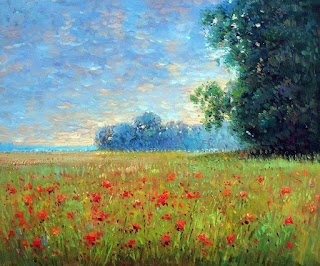Glass artists need to be very cognisant of light and dark, both in terms of colour selection and in terms of density. A very thick dense glass of a dark shade of any colour will create a much more intense darkness than glass that is thinner and less dense.
In terms of colour, lighter hues go where the sun shines or where the eye is to be drawn. Pastel shades indicate brightness and light. Within some opalescent and art glasses it is possible to find a shade of colour graduating to white or light yellow.
Shading can be achieved by using the white areas to indicate where light is falling. A denser dark glass can be used to indicate where light does not fall, or where very little light can filter through. It can also play the part of negative space.
The contrast between light and dark can be used in several ways. Darkness can indicate depth of field or distance when used in a general landscape. Or, it can be used to bring a foreground out, making other elements more vivid.
The key thing to remember in using stained glass is to not be afraid of dark glasses. They can very useful, even if of very odd hues of colour.






No comments:
Post a Comment